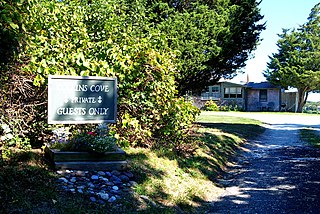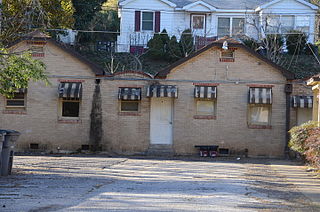
The Collins Cottages Historic District is a historic district encompassing a summer cottage resort in southern Eastham, Massachusetts. It consists of a group of small cottages built by Lewis and Bernard Collins in 1928-29 on a parcel of land on the shore of Town Cove, and were typical of a type of accommodation offered to tourists of the time. The property is located northeast of the Orleans rotary, and is accessed via a section of the old state highway. The cottages continue to be operated as summer accommodations by members of the Collins family.

Crystal River Tourist Camp is a motor inn built in 1932 in Cave City, Arkansas. It is the oldest operating motor court in the state. It is built of fieldstones from the Ozarks.

The Goddard Bungalow Court Historic District is located in Des Moines, Iowa, United States. It has been listed on the National Register of Historic Places since 2000.

The Magnolia Commercial Historic District encompasses the historic heart of Magnolia, the county seat of Columbia County, Arkansas. It includes the courthouse square and most of the buildings which face it, as well as buildings along Calhoun and Jackson Streets. The centerpiece of the district is the square itself and the Columbia County Courthouse, a Renaissance Revival structure built in 1905 to a design by W. S. Hull. The square is lined with mostly brick-faced buildings built between about 1899 and 1910, and between 1938 and 1958, when the city experienced a second building boom. The oldest known surviving building, then as now housing a pharmacy, is located at 111 S. Court Square. One prominent building from the second building phase is the Cameo Theater Building, an Art Deco design built in 1948.

The Paragould Downtown Commercial Historic District encompasses the historic central business district of Paragould, Arkansas. The city was organized in 1882 around the intersection of two railroad lines, which lies in the southwestern portion of this district. The main axes of the district are Court and Pruett Streets, extending along Court from 3½ Street to 3rd Avenue, and along Court from King's Highway to Highland Street, with properties also on adjacent streets. Prominent in the district are the 1888 Greene County Courthouse, built during the city's first major growth spurt. Most of the district's buildings are one and two stories in height, and of masonry construction. The National Bank of Commerce Building at 200 S. Pruett is a notable example of limestone construction, and of Classical Revival styling found in some of the buildings put up during the city's second major growth period in the 1920s.

Woodland Courts is a collection of tourist cabins in Hardy, Arkansas. They are located along Dawson Street, between Echo Lane and Springwood Street. They are ten vernacular wood frame structures finished in a fieldstone veneer, with a gable roof. They are generally oriented to face east, regardless of their position with respect to the street. They were built c. 1938, and are the oldest surviving tourist facilities in Hardy, which had become a noted regional tourist area by the early 20th century.

The Mount Sequoyah Cottages are a pair of historic summer cabins at 808 and 810 East Skyline Drive in Fayetteville, Arkansas. They are both single-story wood frame structures, faced in fieldstone and topped by a gable roof. They were built in the 1920s, around the time that the adjacent Mount Sequoyah Methodist summer camp was developed, and represent a period when the "back to nature" movement was a leading element in the development of summer properties.

The Bellaire Court Historic District encompasses a former tourist court cottage complex at 637 Park Avenue in Hot Springs, Arkansas. The complex was built in the 1930s, when the advent of vacation travel by automobile rose to prominence. The complex is roughly L-shaped, with a long leg of the L perpendicular to the road, and the short leg at the rear, facing Magnolia Street. It is a single story structure with Craftsman styling, built out of wood and finished in stone veneer and brick trim. At the front of the complex is a manager's house, with cottage-style units lined behind it, each with a space that was originally a garage, but has since been filled in as part of a conversion to full-time residential units.

The Bates Tourist Court is a historic traveler's accommodation on Fair Street in Marshall, Arkansas. The property includes four buildings, three of which are stone-veneered wood frame cabins. The fourth building, which original housed the office, has been substantially altered since the facility was built about 1935. The property is rare within Searcy County as a surviving example of 1930s road-based tourist architecture.

The Willmering Tourist Cabins Historic District encompasses a historic tourist accommodation on United States Route 65 in central northern Searcy County, Arkansas, just south of the Buffalo National River. Located behind the Silver Hill Float Service on the west side of the highway stand six stone and timber cabins, with large standstone blocks and plank doors on the fronts, and shed roofs obscured by parapets. Built in 1946 by Harry Willmering, these vernacular structures are representative of tourist accommodations built in the period after World War II to cater to the automobile-based vacationing public.

Cove Tourist Court is a historic former tourist accommodation at 771 Park Avenue in Hot Springs, Arkansas. It is a U-shaped facility, a single story in height, built with wood framing and a stucco exterior in the International Style of architecture. Each of the nine units has an entrance sheltered by a shed roof with Craftsman brackets, and a single-car garage with a two-leaf hinged door. Built about 1937, it is a well-preserved example of the tourist court form in International Style. It has since been converted into residential apartments.

The George Klein Tourist Court Historic District, also known as Green Elf Court, is a historic tourist accommodation at 501 Morrison Street in Hot Springs, Arkansas. Now an apartment complex, it consists of seven single-story cabins, an elaborate American Craftsman style manager's house, and an octagonal central residence unit with a cantilevered second floor and a bellcast roof. The complex was built about 1940, is one of the city's finest example of a Craftsman style tourist court, a popular form of traveler accommodation prior to World War II.

The Lynwood Tourist Court Historic District encompasses a historic tourist accommodation, now known as the Lynwood Motel, at 857 Park Avenue in Hot Springs, Arkansas. Built about 1944, it is a little-altered example of a 1940s traveler accommodation with English Revival styling. It has sixteen units, each of which originally included a garage, and a small office building. Each unit includes a sleeping area, bathroom, and kitchenette, and is marked on the exterior by a steeply-pitched gable.

The Parkway Courts Historic District encompasses a historic tourist accommodation at 815 Park Avenue in Hot Springs, Arkansas. It is a U-shaped tourist court, with 48 units and a building housing an office and manager's residence. The units come in three styles, some with larger sleeping and living spaces, and some with kitchenettes. Each unit is highlighted architecturally by a steeply pitched gable over the entrance. The buildings are brick. The units were built in 1943, and the manager's residence/office in 1950, after the original burned down. It is one of the city's oldest surviving tourist courts.

The Perry Plaza Court Historic District encompasses a historic tourist accommodation at 1007 Park Avenue in Hot Springs, Arkansas. It consists of a long two-story brick building in the International style, along with a small office building and swimming pool. It houses 19 single-bedroom units, which are now rented as apartments. Built in 1947-48, it is a fine example of the International Style. The unit interiors retain a number of period features, including tile and plumbing fixtures.

The Taylor Rosamond Motel Historic District encompasses two historically significant properties at 316 Park Avenue in Hot Springs, Arkansas. The motel on the site consists of two eight-room buildings, one stepped up the hillside perpendicular to the road, the other near the rear of the property parallel to the road. At the center of the property stands the Italianate stone house of W.S. Sorrell, built sometime between 1908 and 1915, and now used by the motel's owner. The motel, built about 1950, is one of the first to be built in the city, beginning a trend away from the older model of tourist courts.

The Jacob Trieber Federal Building, United States Post Office, and United States Court House is a historic government building in Helena-West Helena, Arkansas. It is a Modern International style three-story building, its exterior finished in brick with limestone and granite trim. It was designed by Edward F. Brueggeman and Elmer A. Stuck & Associates, and built between 1959 and 1961. It is one of the city's few International style buildings, and has been relatively little altered since its construction.

The Walter B. Sorrells Cottage is a historic administrative building on the campus of the Southeastern Arkansas Community Correction Center in Pine Bluff, Arkansas. It is a two-story frame building, finished in brick on the first floor and stucco and half-timbering on the second, with Craftsman-style eaves adorned with exposed rafter ends and brackets. Built in 1920 to a design by Pine Bluff architect Mitchell Seligman, it was the first permanent structure of what was then known as the Boys Industrial School, a state facility for troubled youth.

The Shaheen-Goodfellow Weekend Cottage, also known as Stoneflower, is a historic house at 704 Stony Ridge Road in Eden Isle, Arkansas, a resort community on a peninsula jutting into Greers Ferry Lake west of Heber Springs. It is a distinctive Modern structure, designed by Arkansas architect E. Fay Jones and completed in 1965. The main structure is a relatively small rectangular wood frame structure, given vertical emphasis by its placement at the top of a slope and vertical board-and-batten siding. On the lake side of the house a wooden deck projects from the upper level, with vertical railing elements and an outdoor cooking area built in. The house is a clear predecessor to one of Jones' signature works, Thorncrown Chapel, with which it shares design and construction methods, albeit in a smaller scale.

Petit Jean State Park was the first state park of Arkansas, established in 1923 when the United States government decided against the establishment of a national park in the area. A significant portion of its infrastructure was developed in the 1930s by work crews of the Civilian Conservation Corps (CCC), and many of those elements remain in good condition, forming an important element of the park's appearance. The CCC crews built roads, buildings, trails, and the dams which impound Lake Bailey and Roosevelt Lake. These features are described in further detail below. Many of them have been listed on the National Register of Historic Places.


























